Going to the dogs
Posted by Mad Mitch on UTC 2018-03-11 14:32 Updated on UTC 2019-09-28
Last year we published a long article on the Gotthard Pass and the creeping destruction that has befallen the region of the Urserental as a consequence of the modern Swiss transport mania.
Andermatt over two centuries
Two hundred years ago, Andermatt, situated near the top of the Gotthard pass on the junction of the east-west and north-south pass routes, was a village that scraped along as best it could on its earnings from the pass traffic and the meagre income from alpine agriculture. Goethe was fascinated with the Gotthard region and its pass and expended considerable effort to visit it on three occasions.

The Urserental from Realp/Hospental to Andermatt, 2008. The Furka Pass from Wallis enters at the end of the valley at the bottom of the picture; the Oberalp Pass to Disentis, Graubünden, is the route running between the mountain ranges at the back of the picture; the Schöllenen/Gotthard is the gorge at the end of the valley (Andermatt) near the top left. Image: ©Schweizer Luftwaffe 2008.
A hundred years ago Andermatt's situation had become much worse: the Gotthard railway tunnel bypassed the village and reduced the passing trade considerably.
Andermatt and the region around it is plagued by avalanches, which inhibited its potential as a winter sport region. During the twentieth century there were two attempts to flood Andermatt and the Urserental completely with a hydroelectric dam.
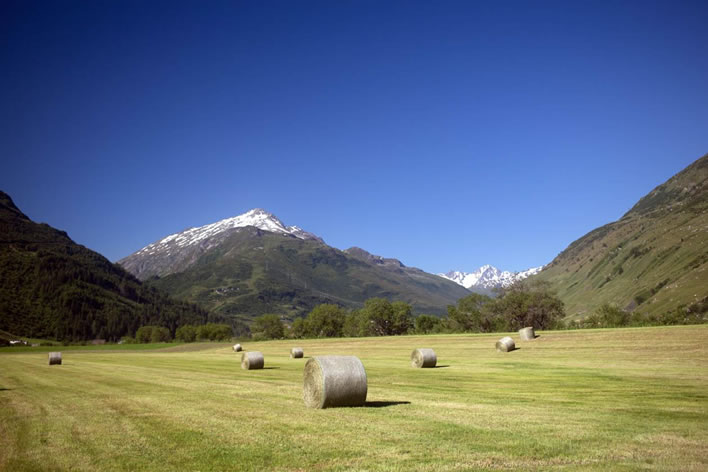
The Urserental: a nice place to be when the sun shines. Image: ©Carlo Pisani, swissinfo.ch.
Fifty years ago the Gotthard Pass road had been improved for motorists. There was more of a passing trade now, but it mainly drove around Andermatt.
The ups and downs of the tourist trade didn't really affect Andermatt, though, because during the conflict years of the first half of the twentieth century the Swiss military took an interest in the location and established a large base next to the village. The existence of a base was a curse disguised as a blessing.
Until recently in Switzerland army bases were used quite blatantly to pump employment and money into economically weak areas. The base at Andermatt, for example, used to employ about 200 of the locals in unchallenging jobs – jobs that were a gentle, stress-free occupational stroll for a few decades before retirement on a generous official pension.
Money flowed to local suppliers and tradesmen and particularly to the restaurants and pubs that kept the troops entertained in the evening. It sounds like a blessing (of the communist sort, though), but this easy comfort inspired only laziness, dependency thinking and dampened all entrepreneurial spirit.
By the end of that fifty years the Swiss Army realized that its bunkers and its encampments in the mountains – historically part of the central mountainous reduit of the Second World War – were now, after the end of the Cold War, military anachronisms. It began its hesitating retreat from these useless and expensive positions, of which the Andermatt camp was one.
The cosy economic rug was pulled from under the locals and they were left sitting on the hard rock of commercial reality.
Twenty years ago Andermatt was a place hardly anyone wanted to visit. It still mowed its high alpine meadows, still made milk and cheese (excellent and memorable, according to Goethe, who liked his grub), but it was an economically backward area in modern terms. The army base had kept it going, but who wants to holiday next to a military camp?
The pact with Mammon, the Devil of the Gotthard
Swiss politicians were desperate to find solutions to plug the economic gaps left by the withdrawal of the army. At that point Andermatt entered the modern world. An Egyptian property speculator bought up the land used by the military at an attractive price and planned a luxury holiday village for a worldwide clientele. A top class hotel was built, blocks of holiday apartments were planned – some were even built – and some of the locals now had employment. The development also brought in workers from outside, thus creating a substantial floating population of foreigners.

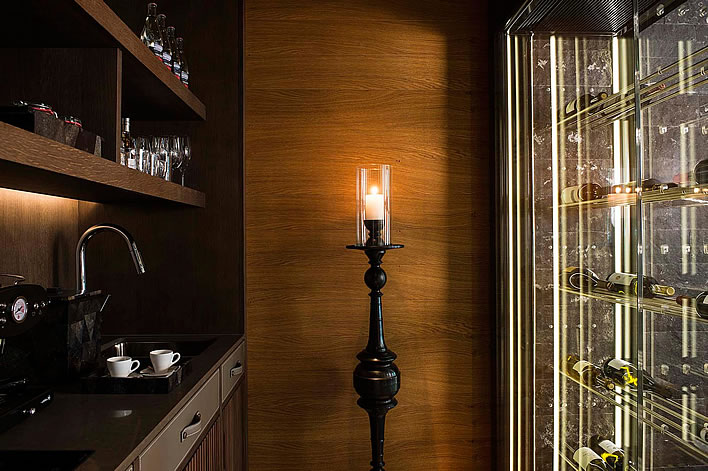
Some views of the Andermatt 'Chedi'. Is this really the taste of the international rich? If you can't get enough of it you can try the 360° version.
The place is not for the cash-strapped: The most basic room in the hotel starts at 600 CHF a night 'on average', the top suite will set you back 11,250 CHF a night 'on average'.
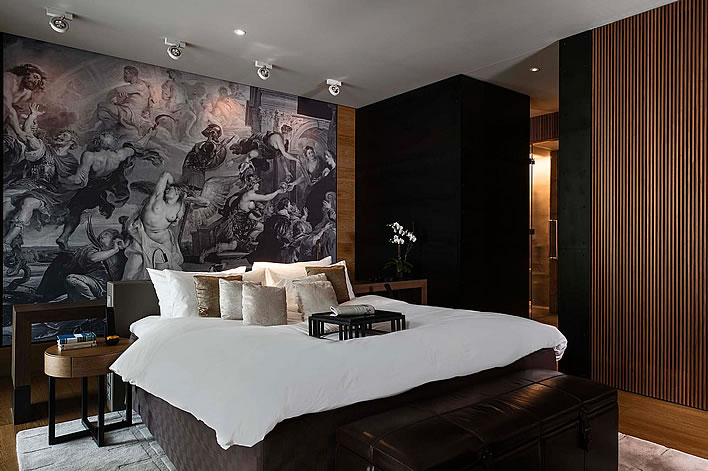
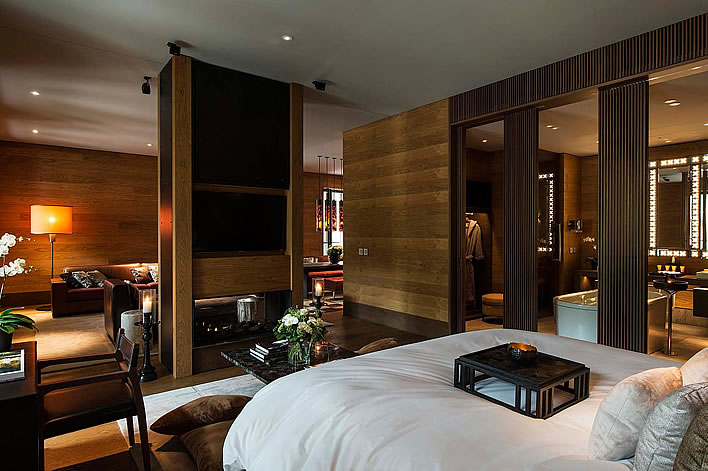
Perhaps the object of the interior design is to make guests feel that they are really nowhere at all in particular, but the careful lack of any feel of 'Swissness' or 'Alpine' is astonishing.
Money and subsidies flowed. The avalanche defences were beefed up and extended, skilifts were built and a ski region was created – a ski region designed to be linked to another ski region in the back of beyond around Sedrun in Graubünden. Winter skiing, that is where the modern tourist money is. In summer there is hiking and that new cash-cow of the moneyed young, biking. Do not ask how many bikers will be staying at the 'Chedi'.
Officialdom did its bit for the new regeneration: permits were issued, public infrastructure was improved, the entire project was supported in countless ways.
At its heart the Andermatt resort project was really just a property development scheme. The idea was that rich foreigners could buy holiday apartments, both in apartment blocks and in the luxury hotel itself. An apartment in the hotel will set you back 15,500 CHF per square metre – one and a half million for a 100 square metre pad – er… plus service charges, of course. At the time of writing, the development is still losing money.
For foreign buyers the scheme was a good investment in stable property prices in a stable country with a stable currency. That scheme, however, was a legal impossibility. The Swiss have a law, the Lex Koller, which is designed to prevent foreigners buying up Swiss property. Never mind – where there's a will, there's a way. The Swiss authorities were so desperate to find a replacement for the military camp in Andermatt that at the end of 2007 that they passed an exception to the law just for the Andermatt development.
The reader asks: So what is wrong with that, you grumpy old spoilsport?
What is wrong with it is that there is never any endpoint to these developments. No one wants to return to the poverty and hardship there was in alpine regions only fifty years ago – and even today in some places. But the cancer of the modern pursuit of money metastasises unstoppably. Any hindrance to its spread is cleared out of its way in short order. It seems that every wilderness has to be made accessible, and when that happens, its essential nature has been corrupted.
I rave? Well, perhaps I do. But bear with me a moment longer.
Herd dogs: the last stand
The latest example of the metastasising of money is the threat to Herdenschutzhunde 'herd guard dogs' on the high alpine pastures. There are wolves and bears, dogs and livestock thieves, and the shepherd or cowherd, hired for the season, cannot be everywhere – he has to eat and sleep like other humans. The best solution is the employment of man's best friend.
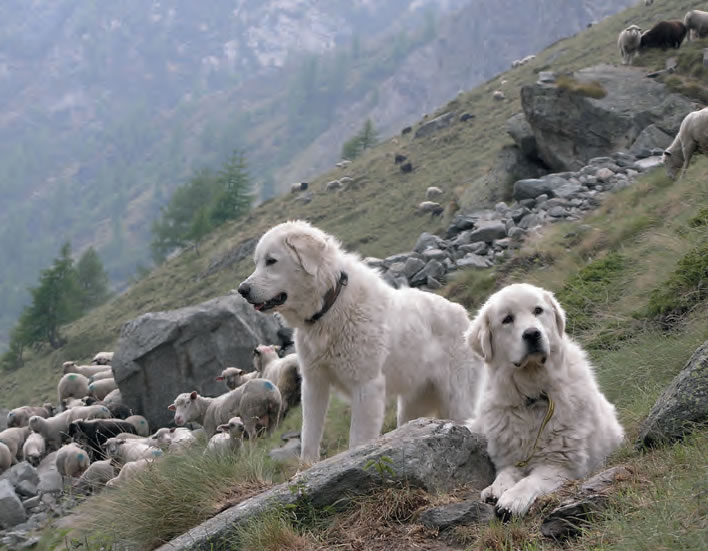

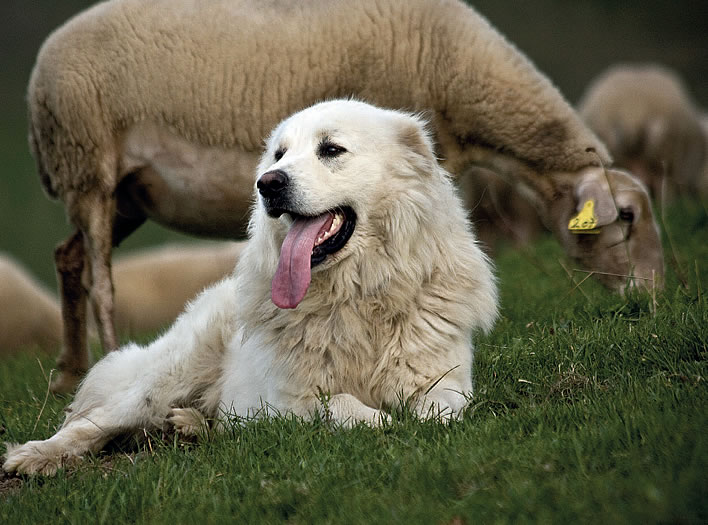
Their whole attention is focused on the animals they guard. The herd dog images on this page all come from either herdenschutzschweiz.ch or protectiondestroupeaux.ch. There are images and downloads available at both sites, many of them in English. Highly recommended.
For thousands of years such men have had the help of herd dogs – large, usually white, hardy and weather-resistant dogs, whose instinct and breeding drive them to defend their herd with their lives. They are sometimes single but more usually work in small packs. They mostly sleep by day and stay very wide awake at nights.
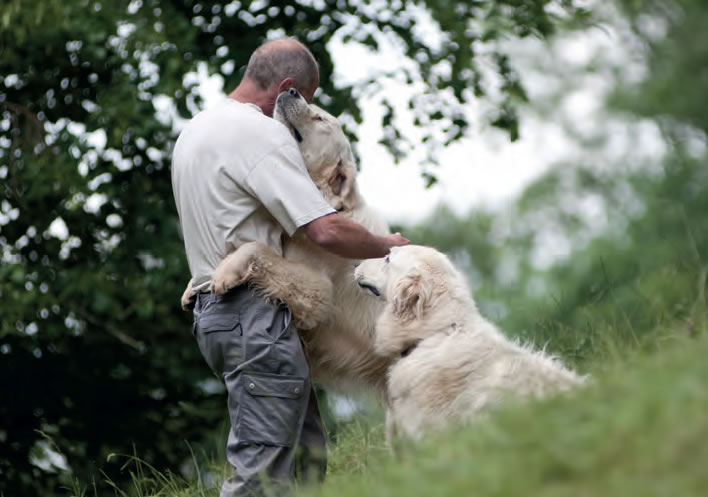
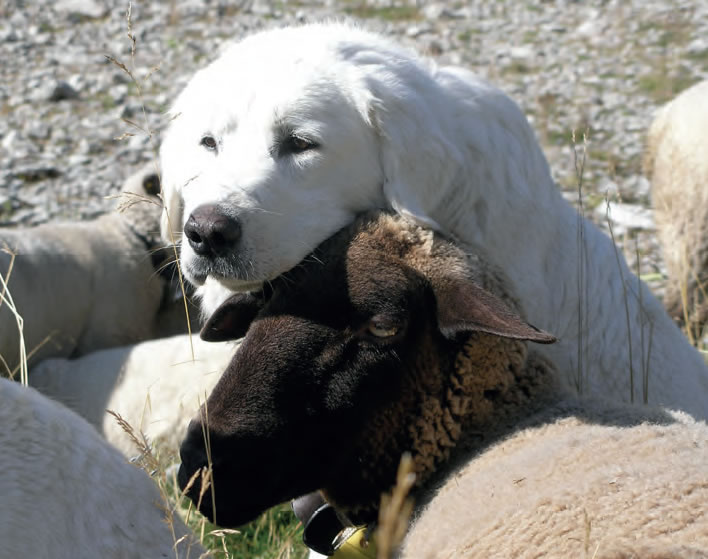
Herd dogs are not wild – they are highly socialised to bond with their masters and with the animals they have to protect.
They are not innately aggressive dogs. I have met a number in the presence of their masters and they are as happy as any other socialised dog to welcome a new entry to their pack. Nor are they violent lunatics: their weapon of choice is their bark.
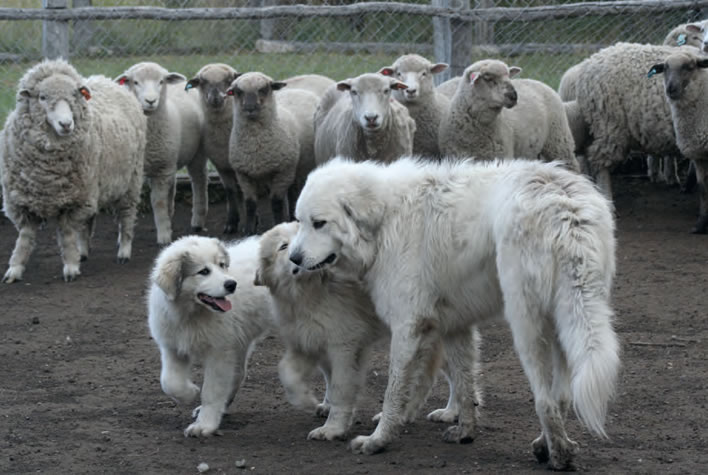

The best teachers are their parents. Puppies spend a much longer time with their parents than those of most domestic dogs do.
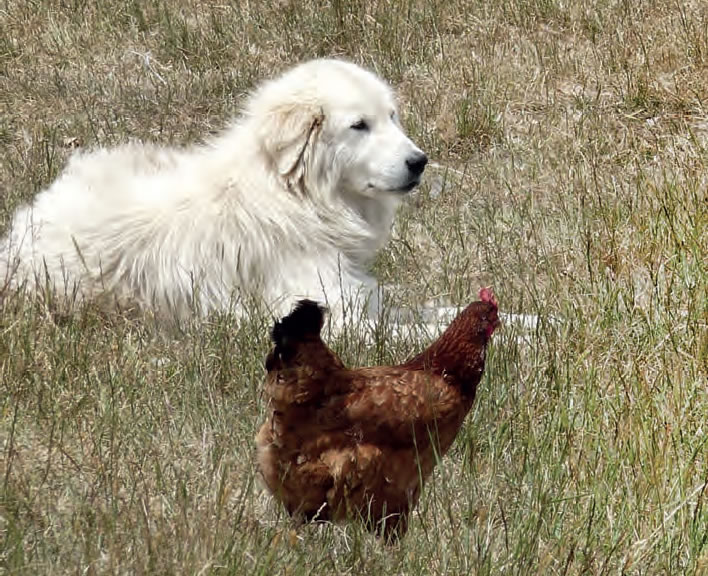
Herd dogs are not predators, they are guards.
When you meet them in the open they give you a warning and you are then expected to behave in a respectful manner – every sensible dog owner will know what that means. They do not simply attack people, they first challenge them. Unchallenged they are no threat to humans at all.
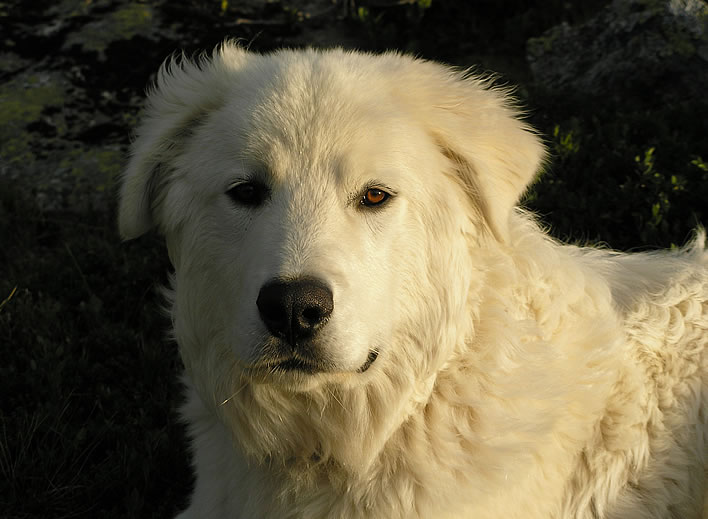
However, those strange, sweaty, fast moving shapes in vibrant Lycra, whose heads are deformed with odd-shaped helmets are a particular challenge for herd dogs. The rule for bikers meeting herd dogs is: when challenged stop, get off your bike, take that ridiculous helmet off so that you look like a human being and then walk your bike like a human being out of their way.
On a bike on rough terrain you cannot outpace them and you will be outnumbered when they get you. Their objective is not to dine on you – having to pick the shreds of Lycra out of one's teeth: how tedious! – but to get you to distance yourself from their herd.
Ramping up the fear
The holiday village in Andermatt imports well-heeled summer visitors from around the world. They go walking and biking. Lowlanders, they have no idea of how to behave with herd dogs. As is to be expected, there have been one or two confrontations between walkers and herd dogs, most of them frights rather than bites.
The authorities in Andermatt are now taking steps to protect their income stream from the reputational damage they fear that incidents with herd dogs will inflict.
One hundred and fifty residents of the local area have launched a referendum initiative, coordinated by the interest group IG keine Herdenschutzhunde, 'No Herd Dogs', which demands a complete ban on keeping such animals in Urserental (the three villages Andermatt, Hospental und Realp). The President of the group is outraged over these dogs: 'The dogs drive trourists away from the paths that we maintain at great expense. In the end they cause more damage than their usefulness'. The local authorities at various levels are now taking an interest. The dogs are not represented on these bodies, whereas the beneficiaries of tourism are. If the political gears grind and produce a ban, this will be the first general area ban in Switzerland.
Given the fact that no one can point to any particular case of anyone suffering appreciable harm from these dogs the call for an absolute ban seems a surprisingly fierce reaction.
Felix Hahn, the Head of the Herdenschutz mit Hunden section of the national agriculture advisory centre, Agridea, is baffled by the demand to ban the use of these dogs. 'In the last four years there has been only one report of an incident, which involved a slight scratch'.
But the problem for the tourist organizers is not the reality but the myth, that because of these dogs, walking and biking in the Andermatt region is perceived to be dangerous activity. The more noise the 'No Herd Dogs' group makes, the farther that perception will spread. Our dog-owning readers will confirm that nowadays very many young adults and particularly their children are utterly terrified of dogs, even more so when the dogs are not on a leash.
Measures 'are being considered' but we can bet that the costs of a few ripped-up sheep or cows are being weighed against the putative costs of lost business. Ultimately, the herd dogs will have to go, of that there can be no doubt. And with them will go one of the last genuinely alpine activities that are left. Yet one more.
Update 10.06.2018
The IG keine Herdenschutzhunde has got its way for the moment: the sheep farmers of the Urserntal have been forbidden to take herd dogs onto the alpine pastures this summer. It will be more difficult to find shepherds who are prepared to spend summer on the high alps without the help of man's best friend.
According to research by the Zurich University for Applied Science, ninety percent of outdoor sports participants are in favour of the use of herd dogs. The vast majority of those interviewed believe that the wolf is a fact of life in the region and sheep require protection.
The real fear is not felt by the tourists but by the tourist managers of the region, particularly concerned for the well-heeled visitors to the luxury hotel Chedi should the the rumour spread that the area is full of dangerous guard dogs. Paradoxically, the noisy panic within the tourist business is only helping to feed the rumours.
The tourist managers have won the first round – and they will win the second round, which will take place if the owners of the pastures take the issue to a referendum.
At the moment, the authorities tolerate the existence of the wolf and compensate farmers for the animals that the wolf kills. Without herd dog protection, this number will increase, meaning that in the end the public purse will be paying for the peace of mind of the tourist bosses of the region. If the bosses had to pay for the damage caused by wolves we might get a rethink.
Update 28.09.2019
Our reader D.J. Clark sent us an information brochure found in a hotel room in Isenthal, Canton Uri, Switzerland: 'What to do when you meet herd protection dogs'. The brochure was designed and published by the French authorities as a Bande dessinée, but unfortunately only published in French and German. If the rosbifs get gnawed by herd dogs – tant pis! This version of the brochure was published in 2016, so we can probably blame the lack of an English version on Brexit.
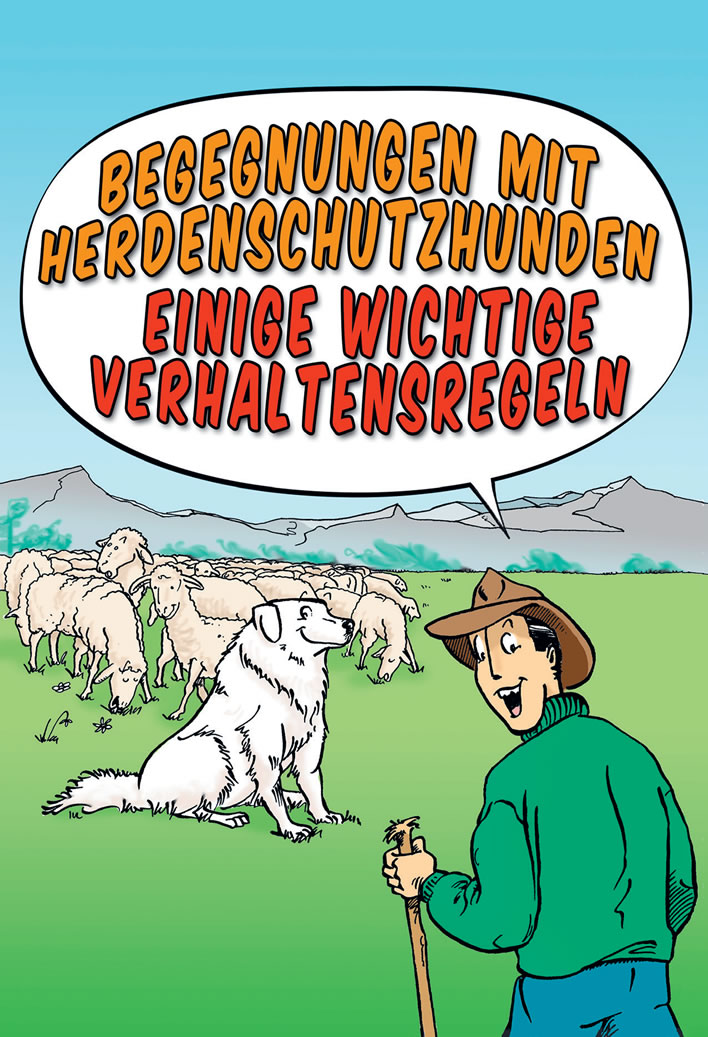
|

|

|

|

|

|

|

|

|
0 Comments UTC Loaded:
Input rules for comments: No HTML, no images. Comments can be nested to a depth of eight. Surround a long quotation with curly braces: {blockquote}. Well-formed URLs will be rendered as links automatically. Do not click on links unless you are confident that they are safe. You have been warned!